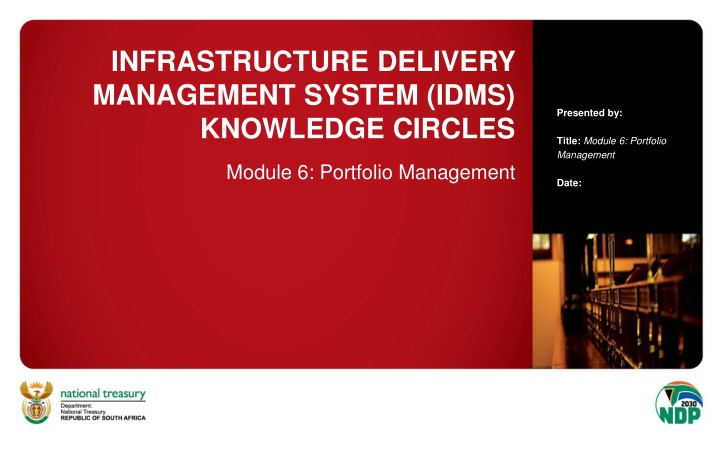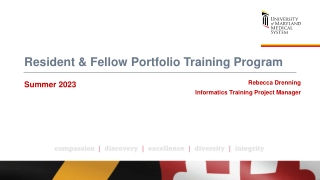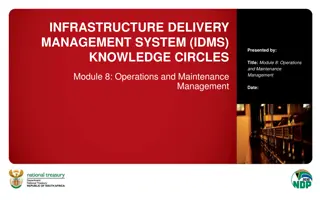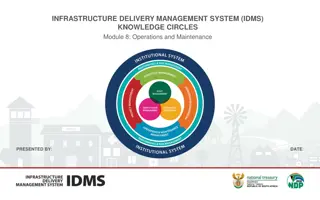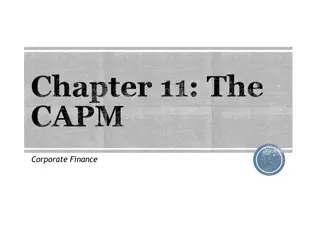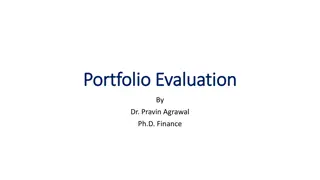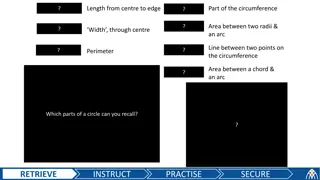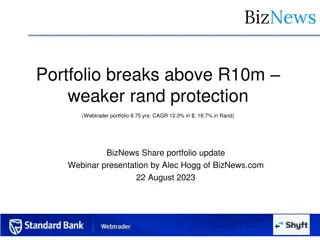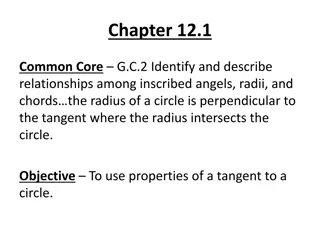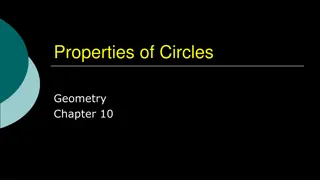Infrastructure Delivery Management System (IDMS) Knowledge Circles Module 6: Portfolio Management
This module delves into the concept of Infrastructure Delivery Management (IDM) within the context of South African organs of state. It outlines the processes and procedures necessary for implementing IDM, focusing on portfolio management as the initial step in a series of four delivery management modules. The module emphasizes the integrated IDM Process Roadmap, showcasing the interconnectivity between the various IDM processes. Through the exploration of governance arrangements, strategic planning, and infrastructure planning phases, this module equips individuals with the knowledge required to sustain the performance of infrastructure assets for public service delivery.
Download Presentation

Please find below an Image/Link to download the presentation.
The content on the website is provided AS IS for your information and personal use only. It may not be sold, licensed, or shared on other websites without obtaining consent from the author.If you encounter any issues during the download, it is possible that the publisher has removed the file from their server.
You are allowed to download the files provided on this website for personal or commercial use, subject to the condition that they are used lawfully. All files are the property of their respective owners.
The content on the website is provided AS IS for your information and personal use only. It may not be sold, licensed, or shared on other websites without obtaining consent from the author.
E N D
Presentation Transcript
INFRASTRUCTURE DELIVERY MANAGEMENT SYSTEM (IDMS) KNOWLEDGE CIRCLES Presented by: Title: Module 6: Portfolio Management Module 6: Portfolio Management Date:
INFRASTRUCTURE DELIVERY MANAGEMENT SYSTEM (IDMS) KNOWLEDGE CIRCLES Module 6: Portfolio Management PRESENTED BY: DATE: 2
MODULE 6 Portfolio Management (Version 5.0) 3
Definitions Infrastructure delivery management (IDM) is defined as The application of the infrastructure delivery management processes of portfolio, programme, operations and maintenance, and project management, to plan and implement the work required to sustain the performance of infrastructure assets needed for public service delivery. (IDMS Definition Module 1) Infrastructure delivery is defined as The combination of all planning, technical, administrative and managerial actions associated with the construction, supply, renewal, refurbishment, rehabilitation, alteration, maintenance, operation or disposal of infrastructure assets. (IDMS Definition Module 1) It is important to note that the delivery management modules relate specifically to infrastructure delivery management in the context of an organ of state, and do not necessarily provide guidelines for all aspects of infrastructure delivery. 4
Module 6: Portfolio Management Module 6 is the first in a series of four delivery management modules contained in the Infrastructure Delivery Management System (IDMS), that together provide the processes and procedures that need to be applied to implement infrastructure delivery management (IDM). Module 6: Portfolio Management is the first of the four delivery management processes: MODULE 6 Portfolio Management Process MODULE 7 Programme Management Process MODULE 8 Operations & Maintenance Management Process MODULE 9 Project Management Process & Project Lifecycle The IDM Processes described in the four delivery management modules are not sequential, and therefore the modules are not meant to be read from cover to cover, or applied sequentially. The Integrated IDM Process Roadmap, included as Figure 4 in this module, clearly shows the integration between the four delivery management modules, and links all of the IDM Processes into one Integrated IDM Process. 5
Table of Contents 1 2 3 3.1 3.2 3.4 3.3 3.4 3.5 4 4.1 4.2 4.3 4.4 4.5 5 5.1 5.2 6 7 Purpose of Module 6: Portfolio Management Learning Outcomes Introduction Applicable definitions and standards Infrastructure Delivery Management (IDM) in the context of South African organs of state Infrastructure Delivery Management (IDM) in the context of South African organs of state Infrastructure Delivery Management (IDM) Processes Understanding the Portfolio of Infrastructure Programmes Governance Arrangement RASCI Table, Process Maps and Procedures Tables Strategic Planning (by Client) Infrastructure Planning Phase (by Client) Authorising and Controlling Phase (by Client) Review Phase (by Client) Improvement Phase (by Client) Subject matter material aligned to this IDM Process and linkages to other modules Infrastructure Delivery Management (IDM) and Infrastructure Asset Management (IAM) Planning in the Context of Government Templates, Outlines, Guidelines & Best Practice Examples References 6
1. Purpose of Module 6: Portfolio Management The purpose of Module 6 is to provide portfolio managers with guidance to enable them to apply portfolio management principles, together with the relevant subject matter material pertaining to infrastructure delivery management, to plan and manage the portfolio of work. It is important to note that the application of Portfolio management on its own is not sufficient to plan and implement the work required to sustain the performance of infrastructure assets needed for public service delivery. It is reliant on workinginsynergy with the other three delivery management modules of Programme Management, Operations and Maintenance and Project Management. 7
1. Purpose of Module 6: Portfolio Management Key points: 1. To providePortfolio Managers with relevant guidance. MODULE 6 Portfolio Management Process MODULE 7 Programme Management Process on its own is not sufficient: MODULE 8 Operations & Maintenance Management Process 2. It is reliant on working in synergy with the other three delivery management modules of Operations and Maintenance, Programme Management and Project Management. MODULE 9 Project Management Process & Project Lifecycle 3. Delivery management modules are generic, scalable and applicable to all spheres and sectors of government, including state-owned enterprises. Organs of state are encouraged to adapt the processes and procedures tables contained in the delivery management modules to their policies and specific needs. 8
2. Learning Outcomes The reader should understand the relevance of the Portfolio Management Process, including an understanding of: How the Integrated IDM Process flows between all four delivery management modules, and the linkages between other IDM processes of Programme, Operations and Maintenance and Project Management; Portfolio Management in the context of infrastructure delivery management within the public sector; Where Integrated and linkages can be identified in: The cyclical nature of the Portfolio Management Process; How to apply the Plan-Do-Check-Act (PDCA) as a management tool that contributes to continuous improvement; How to apply the Responsible-Accountability-Support-Consult-Informed (RASCI) matrix as a management tool that contributes to clarify and define roles and responsibilities on cross-functional processes; The importance of continuous learning, feedback loops and improvement in the Portfolio Management process. Learning outcomes specific to key Portfolio Management phases 10
3. Introduction 3.1 3.1.1 Applicable definitions and standards Portfolio of Work The SANS 21504:2019 (Edition 1) - Guidance on Portfolio Management provides the following definition for a portfolio : Section 2.1 defines a portfolio as a collection of portfolio components grouped together to facilitate their management to meet, in whole or in part, an organisation s strategic objectives . Section 2.2 defines a portfolio component as project, programme, portfolio, or other related work . A portfolio emphasises the work undertaken to meet an organisation s strategic objectives. This is typically referred to as a portfolio of work . Where the work is grouped together into programmes, then the term Portfolio of Programmes is applied. This definition of a portfolio does not include physical assets as part of the portfolio. 11
3. Introduction 3.1.2 Infrastructure Asset (IA) Portfolio The term portfolio is also used in the asset management context, when reference is made to all assets owned or used by an organisation, e.g., an assetportfolio or a portfolio of assets . These could be moveable or immovable assets. In this context, the definition of a portfolio does include physical assets as part of the portfolio. In the context of infrastructure delivery management, the term infrastructure asset (IA) portfolio would normally refer to immovable assets . Some guidelines use the term immovableasset in the place of infrastructureasset . 12
3. Introduction 3.1.3 Linkage the Portfolio of Work and the IA Portfolio The definitions above demonstrate that using the word portfolio without adding the context, can lead to confusion between the portfolio of work being undertaken and the physical IA portfolio. An organ of state would typically have many different portfolios of work, all comprising of different portfolio components, and all contributing towards the achievement of the strategic objectives of the organ of state. The portfolio of work required to sustain the performance of infrastructure assets needed for public service delivery is referred to as the portfolio of infrastructure programmes . The portfolio of infrastructure programmes will be discussed in more detail in Section 3.4 of this module. It should be noted that neither a portfolio of work nor an IA Portfolio will achieve an organ of state s strategic objectives. Infrastructure assets are a means to an end, but are almost never the end in themselves. Value can only be derived from an infrastructure asset when it is in use, or in operation. Infrastructure assets are regarded as service delivery enablers , i.e., organs of state use infrastructure to provide services to communities. 13
3. Introduction 3.1.4 Portfolio Management and Infrastructure Asset Management (IAM) Section 2.3 of SANS 21504:2019 (Edition 1) - Guidance on Portfolio Management, defines a portfoliomanager as a person or organisation responsible for applying portfolio management to a portfolio who may be supported by a portfolio management team . It goes on to state in Section 3.2.1 that: Portfolio management should include a set of interrelated organisational processes and methods by which an organisation allocates resources to implement its strategic objectives . The Local Government Infrastructure Asset Management Guidelines define assetmanagement as The process of decision-making, planning and control over the acquisition, use, safeguarding and disposal of assets to maximise their service delivery potential and benefits, and to minimise their related risks and costs over their entire life. The same definition for asset management, as stated above, can be applied to Infrastructure Asset Management ,by adding the word infrastructure in front of assets in the definition. It should be noted that in the context of Infrastructure Delivery Management, the concepts of PortfolioManagement and Infrastructure Asset Management are very closely aligned. 14
3. Introduction 3.1.5 Benefits of Portfolio Management The benefits of portfolio management can be summarised as follows: Ensures alignment with organisational strategies and objectives; Ensures cost effectiveness by selecting the right programmes and projects; Balances competing delivery and developmental objectives; Provides guidance on the prioritising of the work; Provides strategic consideration of the resources, skills and capabilities required for managing the IA Portfolio; Allocates resources, based on organisational priorities and capacity; Creates a portfolio-minded culture. 15
3. Introduction 3.3 Infrastructure Delivery Management (IDM) Processes 3.3.1 IDM Process Diagram The IDM Process Diagram, as indicated in the Figurebelow, has been developed to show all four of the IDM processes together on one diagram, each with their own colour coding as follows: Portfolio Management Process is shown in green Programme Management Process is shown in orange Operations & Maintenance Management Process is shown in blue Project Management Process is shown in red This colour coding is consistent across all the delivery management modules 16
3. Introduction IDM Process Diagram 17
3. Introduction It is important to note that although the diagram shown is called the IDM Process Diagram, it does not set out to show the Integrated IDM Process, and neither does it show the linkages between the four IDM processes. Other diagrams in the delivery management modules are better suited to showing the relationships and linkages between the IDM Processes 18
3. Introduction 3.3.2 Portfolio Management in the context of the IDM Processes The IDM Process Diagram clearly shows the following annual cyclical phases for the Portfolio Management Process: Strategic Planning; Infrastructure Planning; Authorising and Controlling; Review; and Improvement. The Figure below indicates the Portfolio Management Process in the form of a processribbon comprising of phases and sub-phases and their respective phase deliverables. The diagram also shows how the sub-phases are further explained, using different combinations of process maps and procedures tables. 19
3. Introduction Explanation of levels within the Portfolio Management Process 20
3. Introduction 3.4 Understanding the Portfolio of Infrastructure Programmes The portfolio of work is divided, for management purposes, into six infrastructure programmes to differentiate from all other programmes in public service, each with distinct objectives to meet the asset lifecycle management requirements. 21
4. RASCI Table, Process Maps and Procedures Tables 4.1 Strategic Planning Phase The Strategic Planning Phase is the first phase of the Portfolio Management Process, as shown in the Figure below. The Objectives are follows: Strategic planning phase, as indicated above, provides for: A comparison between the assets required and those assets currently available, i.e., demand vs supply; The identification of assets that must be acquired to meet service delivery needs; An evaluation of existing assets, to determine whether their performance is adequate to support the selected service delivery strategy; And document the strategic approach in the Strategic Infrastructure Asset Management Plan (SIAMP). 22
4. RASCI Table, Process Maps and Procedures Tables Finding the answers to the following questions forms the basis of the strategic planning approach: Where are we? Where do we want to be? How are we going to get where we want to be, i.e., what are the gaps and how are we going to address the gaps? Infrastructure Asset Strategy Framework (adapted from the National Treasury Asset Management Learners Guide) 23
4. RASCI Table, Process Maps and Procedures Tables Strategic Infrastructure Asset Management Plan (SIAMP). Developing and implementing a SIAMP will provide a detailed understanding of what infrastructure assets are currently owned, their value, their future value, and costs associated with operating, maintaining, renewing them (or acquiring new), or disposing of them. Having a SIAMP in place will allow an organ of state to best manage its assets, and deliver services as efficiently as possible, where: An understanding of how effectively the assets being utilised can be determined; The value, over the entire lifecycle of an asset, can be determined and planned for; Costly assets that are not deemed necessary can be disposed of, and can generate funding from their sale. The SIAMP should also provide an understanding of the human resource capacity requirements, system requirements, and an understanding of the IAM training that is required. Details of the level of IAM training, of both staff and top management, is a vital part of understanding the current situation. 24
4. RASCI Table, Process Maps and Procedures Tables In summary, the SIAMP should comprise the following: The expected levels of service; The IAM Strategic Objectives; The performance measures and targets; The risk register and the organ of state s approach to risk; The organ of state s approach to incident management; The IA Lifecycle Management (LCM) Strategies. 25
4. RASCI Table, Process Maps and Procedures Tables Learning Outcomes (Section 2 of the Module) Learning outcomes associated with the Strategic Planning Phase include an understanding of: How to develop the Infrastructure Asset Management (IAM) strategic objectives, lifecycle management (LCM) strategies and delivery management strategy and to apply these to prepare the Strategic Infrastructure Asset Management Plan (SIAMP) that is aligned with these objectives and strategies; How to analyse the Infrastructure Asset (IA) Portfolio using the IA Portfolio Performance Report received from the custodian of the Infrastructure Asset (IA) Register. 26
4. RASCI Table, Process Maps and Procedures Tables 4.1.1 Review IAM Objectives Sub-phase Review IAM Objectives Process Map 27
4. RASCI Table, Process Maps and Procedures Tables 4.2 Infrastructure Planning Phase The Infrastructure Planning Phase is the second phase of the Portfolio Management Process, as shown in the Figure below. The objective of the Infrastructure Planning Phase is to develop LCM Plans and IAMPs for the work required at each facility or IA network and to consolidate these LCM Plans into a consolidated zero-based LCM Plan. This section describes a recommended approach for Infrastructure Planning, i.e., the process for the development or review of the IAMP(s). The IAMP is defined as a prioritised list of programmes and projects to be implemented against a forecast infrastructure budget over the prescribed planning period (refer to the AIMP Template). 28
4. RASCI Table, Process Maps and Procedures Tables 4.2 4.2.1 Infrastructure Planning Phase Review LCM Plans Sub-phase A.2.1 Review LCM Plans Sub-phase Procedures Table No. Sub-phase / Activity Name and Definition Description Inputs Outputs A.2.1 Review LCM Plans A.2.1.1 Obtain Business Cases and/or Statements of Works (with LCM Plans) for new projects, upgrades and/or additions from programme manager(s) The Business Cases and/or Statements of Works (with LCM Plans) for new projects, upgrades and/or additions needs to be obtained from the programme manager(s). Step 1: Receive Business Cases and/or Statements of Works (with LCM Plans) for new projects, upgrades and/or additions from the programme manager(s). Request to programme manager(s) for Business Cases and/or Statements of Works (with LCM Plans) for new projects, upgrades and/or additions. Business Cases and/or Statements of Works (with LCM Plans) for new projects, upgrades and/or additions. A.2.1.2 Obtain zero-based OMP, MMP and RMP from operations and/or maintenance manager(s) The zero-based OMPs, MMPs and RMPs need to be obtained from the operations and/or maintenance manager(s). Step 1: Receive zero-based OMPs, MMPs and RMPs from operations and/or maintenance manager(s). Request to operations and/or maintenance manager(s) for zero- based OMPs, MMPs and RMPs. Zero-based OMPs. Zero-based MMPs. Zero-based RMPs. 29
4. RASCI Table, Process Maps and Procedures Tables Learning Outcomes (Section 2 of the Module) Learning outcomes associated with the Infrastructure Planning Phase include an understanding of: The importance of asset lifecycle management (LCM) and the necessity for zero-based LCM plans for infrastructure assets; Balancing existing commitments, maintenance & repairs, upgrades & additions and renewals (rehabilitation & refurbishment) of existing assets, and the acquisition of new infrastructure assets, as well as the understanding of the concept of deferred maintenance; How to prepare the Infrastructure Asset Management Plan (IAMP). 30
4. RASCI Table, Process Maps and Procedures Tables 4.3 Authorise Programmes/Projects Sub-phase The Infrastructure Planning Phase is the second phase of the Portfolio Management Process, as shown in the Figure below. The objective of the Authorise Programmes/Projects Sub-phase is to formalise the acceptance and approval of all pre-requisites for implementation of the proposed programmes and projects. Programmes and projects must be approved by the person or body designated in the institutional policy arrangements to do so. This process should formally allocate financial and human resources required to either develop business cases or execute selected programmes and projects. 31
4. RASCI Table, Process Maps and Procedures Tables Learning Outcomes (Section 2 of the Module) How to appraise submissions for approval of infrastructure programmes; The responsibility of portfolio management for the approval of phase and stage deliverables and especially the approval of control point deliverables and stage gate deliverables; Managing risk at the Portfolio Management Process level and recommending corrective action as required; The requirements for compiling Quarterly Review Reports and the contents thereof. 32
4. RASCI Table, Process Maps and Procedures Tables 4.4 Review Phase The Review Phase is the fourth phase of the Portfolio Management Process, as shown in the Figure below. The objective of the Review Phase is to review, at planned intervals, the actual performance of the organ of state s assets, and its asset management system, against the planned performance as determined in the IAMP. Top management should review the organ of state s assets, asset management system and asset management activity, as well as the operation of its policy, objectives and plans, at planned intervals, to ensure their suitability, adequacy and effectiveness. Performance measures (i.e., KPIs) are established to set performance targets related to the IAM Strategic Objectives, and to indicate how the organ of state is performing in achieving these targets (see sections 5.2.4). 33
4. RASCI Table, Process Maps and Procedures Tables 4.5 Improvement Phase The Improvement Phase is the fifth and last phase of the Portfolio Management Process, as shown in the Figure below. The objective of the Improvement Phase is to identify, assess and implement opportunities for improvement across the organ of state, through a combination of monitoring and corrective actions for the assets, asset management, or asset management system. Opportunities for improvement should be identified, assessed and implemented across the organ of state as appropriate, through a combination of monitoring and corrective actions for the assets, asset management and asset management system. 34
4. RASCI Table, Process Maps and Procedures Tables Although the opportunities for improvement can be widely different in size and effect, the approach for processing these improvements consists of the following steps: identification of improvement needs and potential; evaluation of options; estimation and determination of financial and non-financial consequences; risk assessment and management of change aspects; links with decision-making criteria; selection and execution; tracking of outcomes and review. Continuous and maturity-based improvement processes should result in the updating of the Portfolio Management Improvement Plan which should serve as an input document for the review of the SIAMP. 35
THANK YOU! 36
